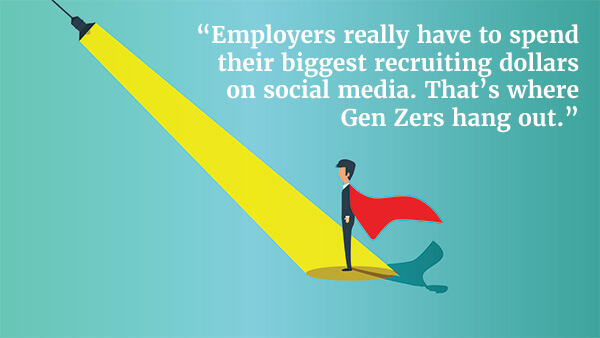How to recruit and retain Gen Z employees in a candidate-driven market. How do you find good workers? And how do you keep them once they’re hired?
Those questions have become top of mind for employers everywhere. Job candidates are scarce. The few who entertain offers end up turning them down. And too many of the ones actually hired go AWOL the first day of work. It’s all part and parcel of a tight labor market that shows no sign of loosening any time soon.
The root problem lies in today’s fastest growing workplace demographic. People under the age of 25 — Generation Z — differ substantially from previous generations. “The candidate pool has changed dramatically from the past,” says Mel Kleiman, director of Houston-based Humetrics, an employment consulting firm. “They differ in their job expectations and in how they communicate
with employers.”
Cast your net
Approach Gen Zers the right way, goes the reasoning, and you’ll boost the odds of good hires sticking around. The first thing to understand is the young generation’s high level of trust and devotion to the internet. “Employers really have to spend their biggest recruiting dollars on social media,” says Don Phin, a management consultant in Coronado, California. “That’s where Gen Zers hang out.”
But which social media, exactly? Turns out it makes a difference. “Gen Zers generally are not on Facebook like some of their older peers,” says Toronto-based management consultant Randall Craig. “They tend to consume more of their content on TikTok and Instagram. So, that’s where companies need to make their presence known.”
Posting on such media carries risks and complications of its own. The No. 1 problem is setting the right tone. Just duplicating the stuff sent to traditional media outlets won’t cut it. Instead, posts have to reach the younger crowd through a flavor of irreverence — something normally at odds with the corporate image.
Asking an employers’ current crop of Gen Zers to help post is a good idea. So is establishing a presence on a number of platforms, respecting the milieu of each. “Posts on LinkedIn or your corporate website need to be more traditional, while posts on Instagram, Twitter or TikTok may be more playful,” Craig says.
Current workers also can perform a recruiting function on other vehicles. “Encourage employees to share open positions on messaging apps such as WhatsApp, Facebook Messenger and through texting,” Craig says. “Private shares of such information come with implicit third-party endorsements.”
Finally, employee referral programs can play a vital role in attracting quality people. “Employers need to make it easy for everyone to recruit and give them enough reward to incentivize them,” Phin says. Leader boards can foster a spirit of competition while bonuses can reward success.
Draw them in
Social media posts must include the right bait to make prospects bite. That means including information they want to see. “The top three things employers can put in their postings to attract Gen Zers are salary, benefits and scheduling flexibility,” says Jason Dorsey, president of The Center for Generational Kinetics in Austin, Texas.

The salary part might seem surprising, given the reputation the youngest working generation has for social concerns. “Gen Zers value salary not because they’re greedy, but because of their life experience,” Dorsey says. “They went through the Great Recession with their parents, then they entered the workforce and lost their jobs because of the pandemic. Now they’re trying to make up for lost time — an impetus all the more urgent with inflation going through the roof.”
Putting information in the right place is important: The three elements — salary, benefits and schedule flexibility — must appear at the top of each job posting, because Gen Zers may read only the first paragraph of posts on their mobile devices. “You need to put all the sizzle that’s normally at the bottom of your job postings all the way at the top,” Dorsey says.
One more factor to include in your job postings: stability. Again, this is not a characteristic many people would associate as important to young people. But it is — because of their experiences with job losses resulting from the Great Recession and the pandemic. “Stability is a hidden behavioral driver for Gen Zers that employers need to be talking about,” Dorsey says.
Looking good
Once Gen Z candidates arrive at the workplace, they must be impressed by what they see. “The picture today is less about candidates selling themselves to employers, and more about employers selling themselves to candidates,” Craig says. Given the mobility of the current workforce, people today want to make sure they move to a place they want
to stay.
How do you accomplish that? “Each business must have a unique employment proposition,” Kleiman says. “It’s the flipside of the old ‘unique selling proposition’ which told why customers should patronize a company. Today, employers need workers more than customers. So, they have to answer the question ‘Why should prospects come work for me?’ ”
The answer can be a detailed array of qualities, or it can be simple, Kleiman notes. “One company boiled it down to two key words: ‘The reason you come to work for us is because we care. We care about our employees, we care about our customers, we care about the community, we care about our environment.”
Part of a unique employment proposition is a company culture that is attractive to Gen Zers. “Every organization must look inward and ask, ‘Are there things we need to change in how we work with our employees and in our culture?” says John Dyer, a consultant in team-based process improvement. “Do we need to re-examine the values we demonstrate day in and day out to develop an environment that attracts the best people?’ ”
Inclusion is a vital part of that environment for a generation deeply concerned about social issues. “Gen Zers are the most diverse generation we’ve ever had,” Dorsey says. “They celebrate diversity and expect it everywhere.”
Burnish the image
Creating an attractive work environment is one thing; getting the word out to the public is another. “Every business needs to be concerned about its employment branding,” says William J. Rothwell, professor of workforce education and development at Pennsylvania State University. “What do people in the community say about working at the company?”
The obvious place to start a public campaign is a company’s own website. The most important section is the page with job listings. “It’s surprising how few employers have built great career sections on their websites,” Craig says. “And by that, I mean not just position descriptions, but content that uniquely helps potential candidates understand an organization’s culture and opportunities.” And don’t make it difficult for people to find your career page — they shouldn’t have to use the site map.
One required element: video. “Gen Zers don’t read,” Phin says. “They watch.” He says that employers should post three videos. In the first, the chief executive officer should say who the company is and where it’s going. In the second, a narrator should describe a ‘Day in the Life’ of a typical employee of the business. In the third, employees should give testimonials on how attractive the company is as a place to work.
Businesses should also take steps to improve their images on Glassdoor.com — the website many prospects use to assess prospective employers. Any negative reviews can highlight needed systemic or cultural changes.
Make it easy
Given all of the above, the employer who lands the interest of an attractive Gen Z candidate must strike while the iron is hot. Doing so requires a streamlined hiring process. “Reduce the hoops you require candidates to jump through by judging the necessity of every hiring step,” says Rebecca Mazin, a co-founder of the Tarrytown, New York-based human resources firm Recruit Right. “If you find a candidate through social networking, for example, don’t demand a resume before you talk to them. They might not have one.”
And don’t demand they fill out a job application, either. That’s making them jump through another hoop that a competing employer may not require. Mazin suggests having the candidate fill out the application as part of the onboarding process after the hire takes place.
Applications should be fully completable on mobile devices. “Gen Zers have a different natural relationship with technology than other generations,” Dorsey says. “When they apply for a job, they expect to be able to complete the entire application on their phone. And it must be easy to do.”
Unfortunately, more than 50% of phone applications are never finished, Dorsey adds. That’s why it’s important to collect an email address or cell phone number early, allowing the employer to send an email or text a day or two later inviting the candidate to finish the job application. The app should save the previously entered information, so the candidate is spared any unnecessary work.
The follow-up invitation should be heavily personalized with phrases such as “We think you might be a great fit” and “We would love for you to finish your application.” Those messages can make all the difference when it comes to completed applications, Dorsey says.
Keeping them aboard
The hiring manager’s job isn’t done when the Gen Z candidate becomes an employee. “What gets somebody to apply is different from what will get someone to stay,” Dorsey says. Employers must work on retention from Day One.
A personalized introduction to the business can make a tremendous impression. So can an entrance interview designed to discover what makes a new hire tick. “Find out why the person came to your organization,” Phin suggests. “Did they choose your company for the pay? The type of work? The location? Because their friends are there? Their answers will help you design a program that encourages them and their friends to stay aboard.”
New employees also must be trained properly. Many Gen Zers are older than previous generations when first entering the workforce and they are new to the business environment. They need to learn the right behavior and attitudes.

Training for Gen Zers must be done a specific way. “We often tend to think of training in terms of linear steps,” Dorsey says. “But the younger people are not like that. They are more outcome driven, so they need to see the end scene first.” Show newcomers what success looks like, then walk them through while they have the end game in mind. Provide specific examples of expected performance. Employers can ensure successful onboardings through frequent check-ins during probation periods.
All aboard
Go where the prospects are. Give them the data they need. Then onboard new hires in a way that makes them stay. Employers can win the modern war for talent by combining those three elements into a powerful recruitment and retention package.
“If you want to get the most out of Gen Zers, you’ve got to support them on every dimension,” Craig says. “If you do that, they will perform and tell their friends to come work at your shop.
And when they do leave, they’ll post good things about your company on Glassdoor.”
Above all, employers must create a dynamic workplace that catches the eye of Gen Zers. “It’s easy for people in business to get caught up in what they do,” Phin says. “But it’s who they are that makes the difference. Employers who are attractive don’t have to worry about finding anybody.”




